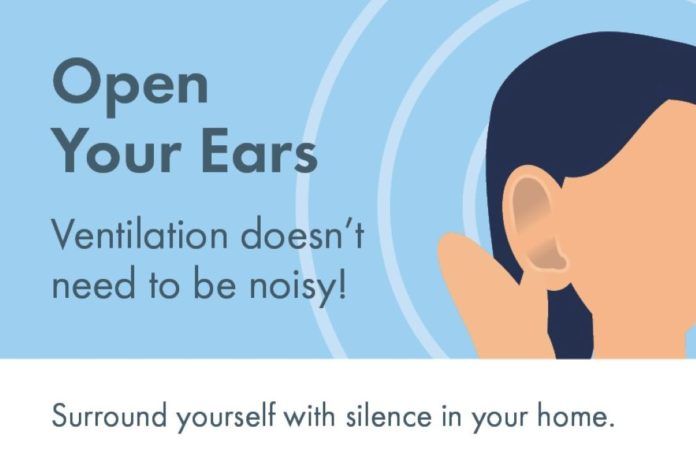
Vent-Axia has voiced its support for Noise Action Week (24-29 May 2021) – raising awareness that ventilation doesn’t need to noisy by offering seven ‘steps to silence’ relating to extractor fans.
Since the start of the pandemic, we have all been spending more time at home, which has led to increased noise pollution. Not only do we have to put up with extra household noise, many are also noticing more noise from neighbours as we all work and socialise at home more than ever before.
Noise Action Week, co-ordinated by Environmental Protection UK, raises the profile of unhealthy noise and the impact it has on our health. With many people using their homes and gardens to entertain, Noise Action Week is reminding everyone to be aware of when and where they are making noise. Excess noise can lead to a number of health problems including increased stress levels, sleep disturbance, depression, anxiety, hypertension and cardiovascular disease.
With the health implications of noise very clear, making a quiet home environment is even more vital. With many people actively seeking out quieter alternatives for many home items, Vent-Axia recommends seven steps to choosing quiet ventilation.
“We are delighted to be supporting Noise Action Week once again. There are many benefits of silence and quiet ventilation helps create a peaceful environment, which leads to a healthy and happy mind and home,” said Lena Hebestreit, marketing manager at Vent-Axia. “Vent-Axia leads the way in silent-fan design with both our Silent Fan and Lo-Carbon Svara awarded a Quiet Mark again for 2021. To properly unwind and relax, it’s vital to surround yourself with silence in your home. So, this year we are sharing seven steps to silence including how to select and site an extractor fan to help create tranquillity in your bathroom.”
SEVEN STEPS TO SILENCE
- Select a fan: The first step is to select a silent extractor fan. Manufacturers have been working hard to improve the acoustics of bathroom extractor fans and so you can now easily select the right fan for the job. For instance, there are fans out there that operate on the threshold of human hearing with intermittent bathroom fans operating at sound levels of only 14dB(A).
- Third Party Accreditation: An easy way to ensure a fan is quiet is to opt for silent fans that have third-party accreditation. Quiet Mark is the independent global certification programme associated with the UK Noise Abatement Society charitable foundation. Through scientific testing and assessment, Quiet Mark identifies the quietest products in multiple categories spanning many sectors, including: home appliances and technology, building sector materials and commercial sector products. Quieter products, such as the Silent Fan and Lo-Carbon Svara, can easily be selected via the online Quiet Mark Directory www.quietmark.com.
- Select the right size fan: Ensure the fan fits the needs of a bathroom, do not oversize a fan. The more powerful a fan potentially the noisier it will be. Also, avoid long duct runs that may result in excessive levels of air resistance, which can be noisy.
- Motors: Look out for extractor fans with high efficiency motors since the ball bearing technology used in them offers smoother and therefore quieter performance. High efficiency motors will also last longer, meaning the fan won’t get noisier over time.
- Silent scheduling: The latest bathroom fans, such as the Lo-Carbon Svara, offer App Control with silent scheduling and automatic cycles, offering flexible ventilation to suit a household’s lifestyle. Silent scheduling allows households to ensure the fan does not go to boost which is particularly useful overnight, or if there is a sleeping baby nearby.
- Avoiding nuisance running: Quiet, disturbance-free running is the holy grail of ventilation. Good options to look out for are: clever light sensors that recognise room occupancy through light movement and shadows; a delay-on feature that can be set to avoid the fan being triggered in the night during quick bathroom visits; and fans that don’t trigger at ambient humidity changes in the night.
- Siting the fan: When choosing where to site fan in your bathroom remember: the ideal site to achieve best performance and keep noise levels to a minimum is the shortest route to outside. If possible, for the quietest installations of bathroom extractor fans, a fan should be mounted directly through an outside masonry wall. Where possible avoid mounting fans on plasterboard ceilings or stud partition walls since the vibration may amplify noise.
